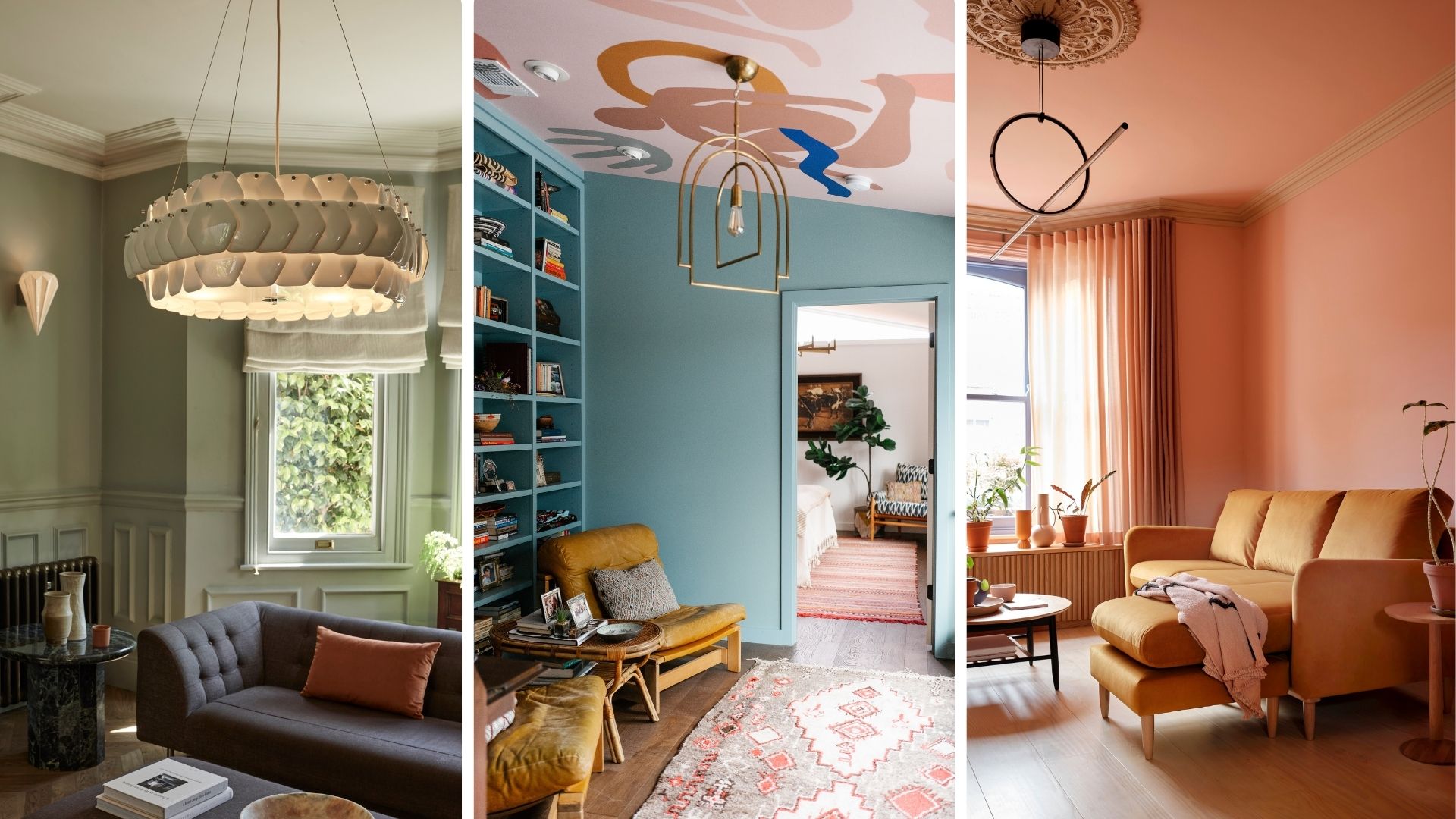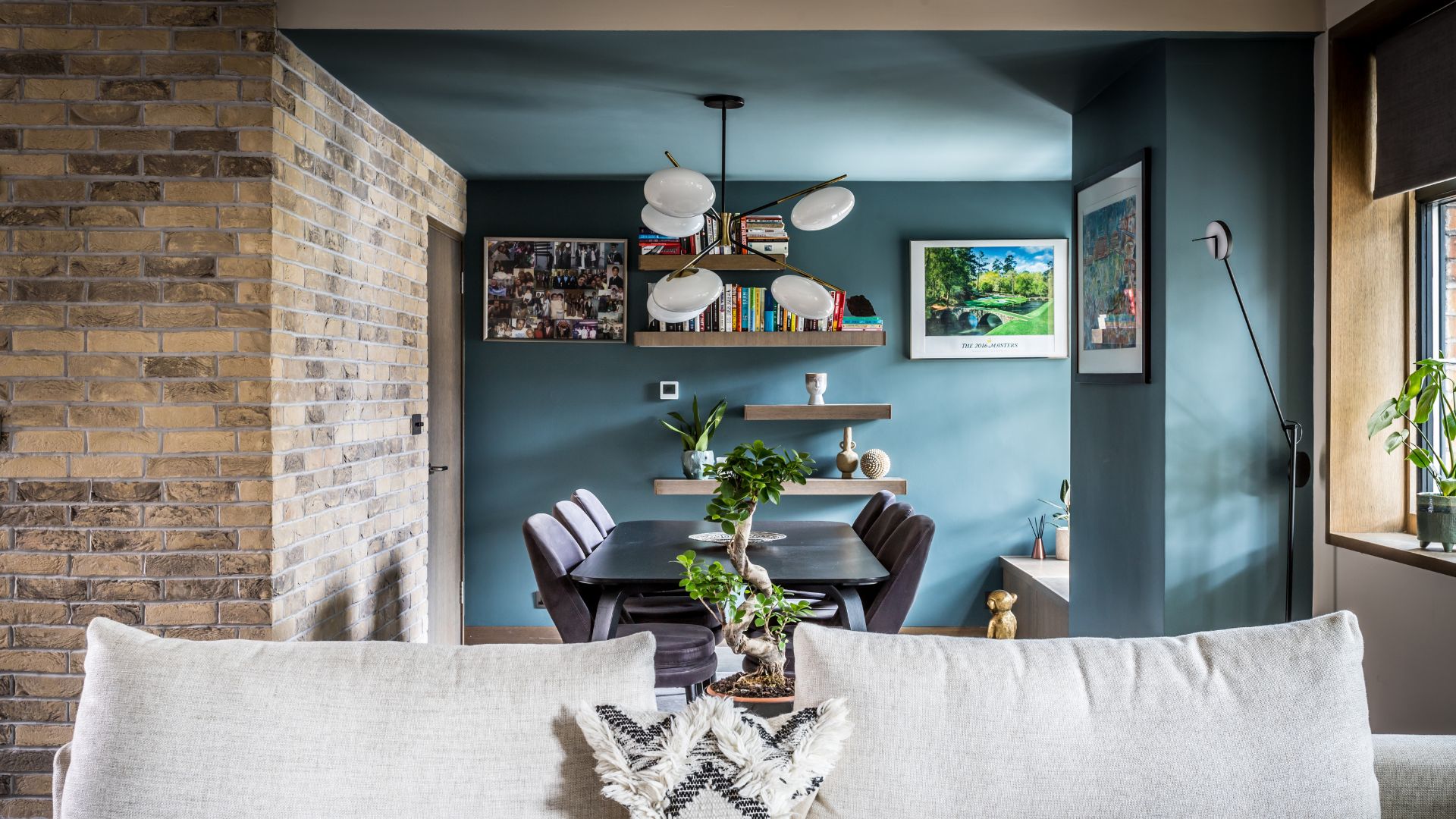When you should and shouldn't paint your ceiling, according to interior designers
No longer is the ceiling painted white and then forgotten, but does a statement 'fifth wall' suit every space?


Painted ceilings have eclipsed the trend for the painted arches we saw everywhere last year and even the mighty accent wall that came before that.
We have a strong suspicion that this interior paint colour trend will be sticking around. Why? Because it can modernise any space, bring some wow factor and even make a small room look bigger in the same way that painted skirting boards can do.
Whether painting our bedroom room ceiling the same colour as our walls for a contemporary colour-drenched look or making a statement with an opulent gold ceiling, there is no doubt that we are giving more thought than ever to our 'fifth wall' with creative ceiling paint colours.
But are there scenarios or spaces that won't suit a painted ceiling? We have rounded up some key aspects to consider before embracing the trend of painting ceilings.
When shouldn't you paint your ceiling?
From ceiling height and paint tone to the desired design style, these are the factors to weigh up before taking your living room paint colour up and over the ceiling in the same way many are painting skirting boards the same colour as walls.
When to paint your ceiling

First, let's look at the positives. A painted ceiling is an affordable and easy way to add a statement feature to any room, as Jo Miller, an interior designer at Decorbuddi explains: "Painting a ceiling can add so much interest to a scheme, creating a focal point, character and wow factor.
"Traditionally, painted ceilings were used to highlight interesting architectural details, such as ceiling roses, ornate cornicing and architraves," Jo continues. "More recently, though, this interior design trend has resurfaced to add interest and ambience to modern and period properties."
Sign up to our free daily email for the latest royal and entertainment news, interesting opinion, expert advice on styling and beauty trends, and no-nonsense guides to the health and wellness questions you want answered.
As well as drawing the eye up and adding a sense of drama, it's also a great way to make a space feel more contemporary. For instance, Jo suggests creating a modern, abstract effect by colour-blocking above the dado or picture rail, or where the picture rail would be, with one of the best colours for ceilings.

Jo Miller has more than twenty years’ experience in interior design and home building. Jo works between London and Bath and has a certificate in interior design from the world renowned KLC School of Interior Design. Jo has a keen interest in the history of architecture and loves to reveal a hidden original fireplace or stone floor and explore the history of the house. Jo is also a qualified upholsterer.

If you want to make a room look bigger with paint, paint your ceiling a shade lighter than the walls as this will make the space feel taller. Go for a darker colour to make the room feel cosy.
Alternatively, you can paint it the same colour as the walls to add cohesion and a more "designed" look. "We tend to love the look of colour-washing the ceiling and woodwork the same colour as the walls as it's the most cohesive and architectural," said Jen and Mar, interior designers at Interior Fox. "The only time you could consider not painting the ceiling is if it was a very dark wall colour and you wanted the separation of space.
"If this is the case, opt for a very light shade or tone in that wall colour rather than a pure white. Your eye will still read this transition as white but won't be so stark. For example, a dark navy blue wall drench could have a pale blue or grey ceiling colour.'

Jen and Mar are the founders of interior design studio Interior Fox. Jen, a former New Yorker with Texas roots, has an eye for "Cali-cool" spaces, and draws design inspiration from her favourite cities: Amsterdam, Brooklyn and Miami. Mar grew up in the Philippines surrounded by interiors full of rattan, natural materials and organic textiles, which have shaped her design style today.
When to avoid painting the ceiling

"Not every room is going to benefit from a painted ceiling," comments Sophie Clemson, interior designer at The Living House. "For instance, if you go for a dark and moody look, sometimes painting the ceiling can make the room feel cave-like and too dark. (a common mistake when decorating with dark colours) As much as I love a painted ceiling, it's good to know when to stop with the dark paint colour," Sophie says.

Sophie Clemson is the co-founder of The Living House, an affordable online interior design company that helps busy families transform their homes easily, online and within their budget.
There are a few other cases in which a painted ceiling could feel oppressive, or just not quite right:
- If you lean towards are more traditional design style, painted ceilings might not be for you. "There aren’t really any cons of painting a ceiling, but if you want a more traditional look, you might prefer to leave it white," comments Jo Miller.
- Ceiling height should also be considered – Jo says that white tends to make a room seem airier, so if you have a very low ceiling, whites, creams and pale tones could be a good choice.
- It may not suit an eclectic interior: "If the interior design is eclectic with different elements and a variety of layers and styles, it may be best to choose a white ceiling to calm the space," says Jo.
Consider if a bold painted ceiling could jar with the rest of your interiors – if the adjoining rooms are light, bright and Scandi, for example, a moody and dark room might feel out of place. It's also worth thinking about what you will be doing in the space and at what time of day.
A ceiling painted in an uplifting and energising colour that you love will feel inspiring in a home office, but too dark a shade could feel oppressive and make the space feel darker. In snugs and dens used in the evening, on the other hand, you may as well embrace the dark and opt for something more cocooning.
Should I wallpaper my ceiling?
"The current trend to put wallpapers on ceilings is being embraced to add a decorative layer to the room while leaving the walls free for artwork and mirrors," says interior designer Jo Miller. "Wallpaper trends on ceilings is a great choice where there is limited opportunity for decorative elements elsewhere, such as narrow hallways," she says.
Otherwise, you can wallpaper on every wall and even break it up with panelling for added texture. If you wallpaper your room, Sophie Clemson recommends then painting the ceiling in a shade within the wallpaper for an easy colour combination.
What colour should I paint my low ceiling?
"Depending on the paint colour you have chosen, I would explore the idea of painting the ceiling the same colour as the walls," says interior designer Sophie Clemson. "This will help to blur the edges and works great if you have a low ceiling because it will blend into the room."
What colour should I paint the ceiling in a small bedroom?
"Paint the ceiling the same colour as the walls in your small bedroom to make the space feel bigger," recommends Sophie Clemson, similar to painting doors the same colour as the walls.
"If you have feature walls or a different colour on the ceiling, it could make the walls feel like they are coming inward, resulting in your bedroom feeling more compact than it really is."
Interior designer Jo Miller says that in children’s rooms, striped ceilings evoke circuses and a sense of playfulness, drawing the eye up and creating a greater sense of space, however colourful. "The addition of maps and clouds is also another great way to achieve a fun space," she says.

Millie Hurst is a freelance writer and interior designer based in Sheffield, helping clients create homes that are characterful, curated, and highly functional. Interior design inspirations include Jake Arnold, Beata Heuman and Abigail Ahern. Her personal style is a 'liveable maximalism' with boho, nature-inspired designs.
She has seven years of experience in the world of digital journalism, most recently working as Head of Solved at Homes & Gardens, where she wrote and edited countless features on home organisation, decluttering and interior design. Before that, she was Senior Content Editor at Ideal Home.


